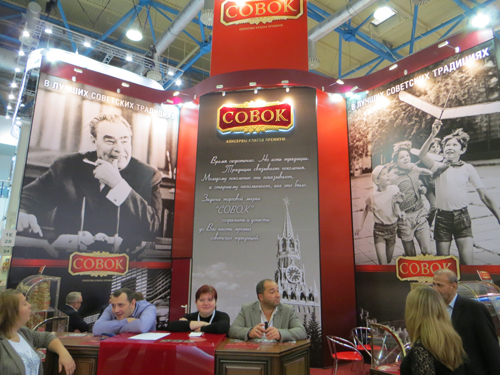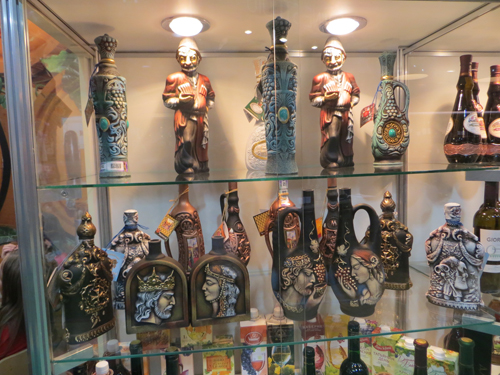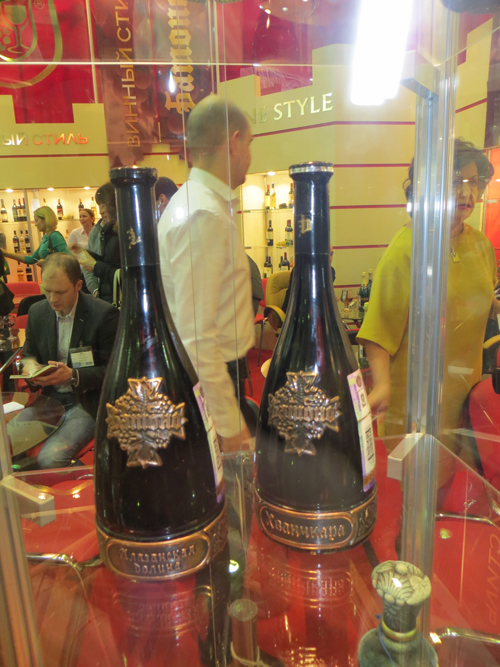By Nukri Kurdadze
In February each year Moscow hosts Prodexpo, international exhibition of alcohol drinks and food products, with participation of distributor-importers as well as producers from various countries around the globe. Popularity of this exhibition has fallen significantly over the past years, as there are less and less large international corporations present, while regional business representatives visit more frequently. This exhibition is an interesting opportunity to study the market, while spectrum of products presented gives a good overview of new tendencies.
Exhibition held on February 10-14, 2014 was especially interesting in terms of studying perspectives and issues associated with Georgian wine. It’s not only about number of contracts signed by distributors, but also about looking at the overall presence of Georgian wine, which would enable me to judge marketing strategies selected by Georgian producers to enter Russian market.
It was predictable and nice to see producers like Telavi Wine Cellar, Khareba, Kvareli Wine, Tamada and Dzveli Tbilisi by GWS, Badagoni, Tavadze Wine, Tbilvino, Viniveria, Chateau Mukhrani, Sarajisjvili (please forgive me for incomplete list). Booths decorated according to international standards, large variety of products and professionalism of personnel made good impression and indicated innovative changes that took place in Georgian wine industry for the past 5-6 years. We can call this group “innovative producers”, as they are already successful entrepreneurs and I am sure they are able to develop their business on a Russian market as well. They have everything needed to achieve this goal: high quality wine, high demand and expectation, labels branded according to international marketing standards and correct pricing policy ranging from 300 to 3,000 Russian Rubles and covers average, premium and prestigious price segments. It was a pleasant fact that this assortment included a large portion of the last two segments. As I inquired price of Khvanchkara, it turned out it cost 1,100 Russian Rubles (approx. $35) and it is sold so quickly that they often lack stock.
I remembered reading opinions of various “experts” in Georgian press on how expensive Georgian wine is and the need for the price to go down in order to have chances on Russian market. I will dare to say that such opinion is at least unprofessional (or it could be dictated from business interests of specific entities). As we talk about wines of two countries, it is necessary to compare the same categories, for example, ordinary table wine of Georgia should be compared with corresponding French Vin de Pay or Spanish Vino De Messa, while aboriginal Georgian wine should be compared to French AOC or Spanish DO or DOC category of wines, etc. Let’s start with aboriginal wines and first of all look at Khvanchkara, Kindzmarauli and Akhasheni of red semi-sweet category. It is difficult to compare these wines with similar western wines, since red naturally semi-sweet wines are rarely produced in the west. Considering legally limited area and demand existing for such wines in different countries, it is impossible for wines of this category to be cheap. This could only happen if there is a large portion of falsified wines on the market, as it happened before embargo in Russia. This fact needs no further proof, but I guess I should note what I saw in Nizhni Novgorod, Russia in 2000-ies – Red Sparkling Wine (!) Khvanchkara.
Any brand of premium segment, which has limitation in production, is demanded and well sold on the market, and is destined for premiumization. A good example of this is Champagne, Cognac and wines of AOC category. There are other ways as well: if the environment in which the producer operates enables illegal manipulations to artificially increase volume. Unfortunately, Russia is an ideal market for such manipulators. This fact requires no further evidence and we cannot hide from it. Even though there is a much better situation in Georgia in this regard, we should still consider experience of the western countries, who impose strict control measures on local wines and difference in volume in certain special zones is few kilograms only. Georgia has very few local wines. For example, in Spain there are 68 such wines, while just Bordeaux in France has 57.
More efforts are needed for local dry white and red wines in Georgia like Mukizani, Gurjaani, Tsinandali, etc. But as they are well-recognized and limited in volume, problems are less likely to occur in case of well-planned marketing campaign.
As for table wine segment, it is one of the largest in terms of volume and overloaded with competition. This, first of all means new country wines. Success of wines of new countries is a large topic on a global scale, but it could be summarized as follows: price – good indicator of quality, which is first of all determined by the use of innovative technologies and innovative marketing. Even though there are modern enterprises in Georgia, with the first indicator above Georgia cannot compete with the new world, simply because modern innovations are not as cheap and its use for price purposes is only valid in case of a large production volume. Example of Australian Jacob’s Creek is a good illustration: this Australian brand sells 75 million liters worldwide, which is almost twice as much as total Georgian export at the moment. This does not mean that ordinary Georgian wine requires reduction of price. These Australian producers spend tremendous amount of resources to increase awareness of their brands and create appropriate image. Georgian ordinary wines have sufficient recognition, but as for the image – as soon as there is more of so called “Sovok” style, the irreversible process of lumpenisation of this segment as well as Georgian wine in general will start.
Unfortunately, my visit to Prodexpo exhibition halls was not limited to pleasant discoveries only. My 15 years of experience of working on Russian wine market prompted that I would most likely see unforeseen surprises, for which Russia is notorious. Unfortunately, it exceeded my expectations.
There was a big number of so called “new wave” Georgian wines, but the brand names told me nothing as I have seen none of them in the shops of Tbilisi, apart from few exceptions. The first thing that caught my eye was a large number of clay bottles or pot sculptures, and I’ve struggled to find appropriate name for these items. To justify their existence you would often hear that such design is a true reflection of Georgian traditional wine. Until 2006 the clay esthetics was part of Georgian wine, so I more or less expected its reincarnation, but I had no idea that some of the producers would go so far in their creativity. I mean metal armor-bondages and strange epaulettes that still remain as mystery to me.
I advise “followers” of traditions to look at history, remember bottle decoration styles of prince Kipiani, Bolkvadze, Ivane Bagration-mukhranski and other producers of that time, even miserable labels of soviet period and they will be easily convinced that what they now call “Georgian traditional design” is nothing more than poor design created specially for Russia in late soviet and 90-ies bandit period, and which have nothing common with Georgian wines and I would personally call it “commoner style”.
Some exhibits justly deserved the title of the least and most uncreative. For example, masterpiece of Mimino. Due to my occupation I have tried great deal of wines: good, bad, average, strange, etc. But I think it was the first time, at the booth of Mimino, where I actually felt sorry for wine, when I saw wine bottles wrapped in cloths or overalls of unclear sharp color, and covered with royal crowns. On the right to this disaster, there stood a typical whiskey bottle covered in armor with “Kindzmarauli” label, while on the left there were Mukuzani and Tsinandali in bottles of weird shapes. I ask the reader to pay attention to half-naked woman on the front of this art. As I asked the owner of the booth, an energetic man of unclear nationality and gave a mock compliment towards this unique booth, he took it seriously and with great pleasure shared an important constructive know-how: metal sculpture is empty from inside and sufficient to be placed over Mimino bottles and pots. After such simple manipulation the neck of the bottle shows up in a tube coming out of the head of the woman… I leave comments to readers.
Trademarks Mikitani and Zedashe were presented at the booth of Driada Group. Promo brochure says: “Mikitan”i was the name of wine carriers in Georgian provinces until the 19th century” (!). It also provides an interesting historic fact: seems like Mikitanis were the biggest experts on wine. For information, in Tbilisi of the 19th century there was a network of “Siraji-Mikitani”, who bought wine from peasants in the villages for cheap price, then mixed it with water and sold to Mikitani for more. The latter, on their own hand, added more water and offered it to the public in their Samikitnos (“house of Mikitani”, like tavern). The problem reached such a huge scale that clerks of that time created a special committee to combat Siraji-Mikitanis. I want to tell “protectors of these ancient traditions” that phenomenon and psychology of Mikitani still have not disappeared from Georgian conscious and will exist for a long time due to them, unfortunately.
I was extremely surprised when I saw 2012 Цинандали (Tsinandali) and Алазанская Долина (Alazani Valley) by Shota Rustaveli. I am following the style here, which indicated the brand in English, while names of wines in Georgian and Russian languages. It is interesting whether Georgian legislation allows using Shota Rustaveli as a trademark.
It turns out, Mikitani and Shota Rustaveli brands are both produced by Georgian Wine Corporation. What can I say, a great Georgian poet ended up in a wonderful company.
РВД- Русский винодельческий дом (Russian winery house) which is part of MG Group offers the following trademarks in their booths and promo brochures: Грузинский стандарт (Georgian Standard), naturally associated with the Русский стандарт (Russian Standard) vodka, and Шато Гурджаани (Chateau Gurjaani). All of these wines are presented in bottles of strange shapes. Another exhibit of the same producer, Georgian Traditions wine is also interesting, which is, for some strange reason is bottled in cognac bottle. However, it all came together as I saw Бакинский Бульвар (Baku Boulevard) in their catalogue, in a similar bottle and similar design.
This is an incomplete list of masterpieces I saw at the exhibition, but some conclusions can be made:
The principle of business using methods and ways that bring material benefit works in every country and is a main driver for generating new business ideas. However, this does not mean all methods and ways, but only those allowed by general or sectoral legislation. It is difficult to imagine high classification French, Spanish or Italian wines bottled in clay pots in the shape of Eiffel Tour, Mona Lisa, or toreador. This has nothing to do with lack of creativity of wine-makers of these countries. We should not even think that there are no businesspersons who would not create similar masterpieces for Russian markets. Such fact has a simple explanation – wine legislation imposes strict control for packaging and labeling high classification wines, although simple table wines would not be left without attention as well. I could have an opponent that may tell me that such design is well sold in Russia, so what can be done. I agree with the virtual opponent and at the same time, I “advise” to undress the clay lady not only to the chest, but fully, act more daringly and it will be sold better.
These “new/old tradition” producers have one thing in common. Each of them offers aboriginal wines like Khvanchkara, Kindzmarauli, Akhasheni, Mukuzani, etc. These wines are the ones that carry the load of low design. I don’t think it is difficult for appropriate official agencies to set at least basic principles regulating packaging of local class wines. Let’s remember the basic truism of modern wine industry – image is created not only by the quality of wine, but packaging and marketing strategy as well. It should also be noted that even ordinary wines bottled in clay pots harm the cause: when we package simple wine like Alaznis Veli in clay, this increases its price and the wine ends up in elite wine price segment. When the person buys this wine, tastes it and discovers nothing “elite”, next time he/she will most likely ignore quality Akhasheni in a bottle, which is in the same price segment as Alaznis Veli in clay.
If such masterpieces of “traditional Georgian crafts” were sold in souvenir or dish shop without wine, we would less likely pay attention to it, but when it comes to Georgian wine, we should be more careful.
The issue I discussed in this article is not something that only state agencies should care for. If these “new/old tide” entrepreneurs continue their work the same way, very soon Georgian wine will lose its elite image and will harm already established and developing elite Georgian wine segment, ad the work carried out by noble producers will be lost, to sat the least. I hope they will also have raise their voices.
As for the quality of the wines described above, unfortunately not all distributors allowed tasting, but few samples I tried were of much higher quality than similar style wines before the embargo, and the quality was definitely different from packaging and labeling designs (Ramaz Peikrishvili, producer of “Glakhuna” wine was also tasting the wine with me).
Finally, I will allow myself to give few recommendations to Georgian producers that leave important business of packaging and labeling their wines to Russian partners. Please consider than most of these operators target their business to the Russian consumers of low taste, which is more than 60% of the population and their purchasing ability is not very high. Such consumers are still loyal to soviet values and are above certain age. This category has least perspectives compared to others and decreases each year. The fact that Krasnodar and Kuban wines are most demanded in Russia, the quality of which is obvious based on their names (for example, “Южное танго” (Southern Tango), or “Исповедь грешницы” (confession of a sinner woman), is a good indicator of the taste of such consumer group. Alcohol market players have folk gems from varioys countries in their portfolio, for example, “Любимая кошка” (beloved kitty), “Ночной флирт” (Night flirt), “Молоко любымой женщини” (Milk of a favorite woman), etc. Most of their product turnover falls on wines of such category, so don’t be surprised if they cannot offer creative ideas.
- Совок - word in Russian used to indicate limited viewpoint, low level style, lack of individualism and all negative aspects that were so characteristic for soviet era and are still often visible in post-soviet countries, and unfortunately, even in Georgia.
© Georgian Wine Club / Weekend









